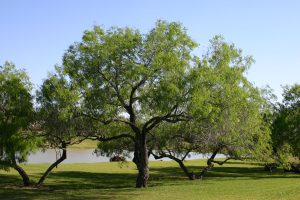
A signature plant of south Texas, the mesquite tree’s popularity as a landscape tree is growing rapidly. Its spreading canopy gives dappled shade and relief from our brutal summer sun. The mesquites pictured above are growing along a slope leading down to a resaca. Mesquite trees are not picky about the soil they grow in. The soil here is heavy clay. They are also salt-tolerant so can be used in coastal areas.
Because of its attractiveness and drought-tolerance, they are one of the backbone trees of water-wise landscapes. Small leaves make it very drought tolerant and easy-care. Whitish catkins (or flowers) appear in the spring and become soft-podded beans by summer. Livestock and wildlife graze on these beans. They have a slightly sweet taste and are often called “Honey Mesquite”.

Mesquite is deciduous but retains some leaves in mild winters. It is fairly tidy to plant along driveways and patios. Expect a small amount of fruit drop in the fall.
This second picture is the view that I often see as I leave for work in the mornings. I expect this was taken in winter since it doesn’t look like the tree has many leaves. But even fully leafed out, a sunrise will filter through the lacey foliage of a Honey Mesquite. It’s definitely one of my favorite South Texas trees.
